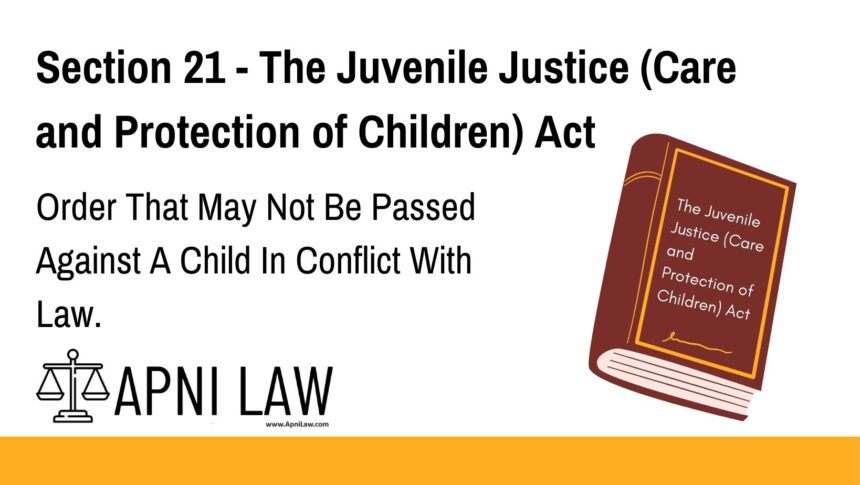Code
No child in conflict with law shall be sentenced to death or for life imprisonment without the possibility of release, for any such offence, either under the provisions of this Act or under the provisions of the Indian Penal Code (45 of 1860) or any other law for the time being in force.
Explanation
Section 21 of the Juvenile Justice Act ensures the protection of children in conflict with the law from being subjected to the most severe forms of punishment, namely death or life imprisonment without the possibility of release. It underscores the principle that children, due to their age and psychological development, should not be subjected to the same severe punishments as adults, even if they have committed heinous offenses.
Key Aspects of the Section:
-
No Death Sentence:
-
Children in conflict with the law cannot be sentenced to death, regardless of the nature of the offense committed.
-
-
No Life Imprisonment without Release:
-
The section also prohibits life imprisonment without the possibility of release for a child found guilty of a criminal offense.
-
-
Application to Other Laws:
-
This prohibition applies not only to the Juvenile Justice Act but also to the Indian Penal Code (IPC) and any other prevailing laws in force.
-
Reason for the Provision
This provision is rooted in the understanding that children are still in their developmental years and may not fully comprehend the consequences of their actions. The justice system recognizes the potential for rehabilitation, and as such, children are treated differently from adults in the criminal justice system.
-
Rehabilitation Over Retribution: The emphasis in juvenile justice is on rehabilitation rather than punishment. A child’s potential for reform should be prioritized, and thus, harsh punishments like death or life imprisonment without parole are considered inappropriate for children.
-
Recognizing Psychological Development: Children are recognized as being more malleable and capable of rehabilitation compared to adults, which is why extreme penalties are deemed inappropriate.
Illustration
Example:
-
Ravi, a 15-year-old, commits a serious crime. Under the provisions of the Indian Penal Code (IPC), such an offense might carry a life sentence or even the death penalty for an adult.
-
However, under Section 21 of the Juvenile Justice Act, Ravi, being a minor, cannot be sentenced to death or life imprisonment without the possibility of release, even though the offense is serious.
-
Instead, Ravi’s case will be handled by the Juvenile Justice Board, and he will be given an opportunity for rehabilitation, with the possibility of reintegration into society after completing the rehabilitation process.
Common Questions & Answers
Q1: Does this mean children cannot be sentenced for serious offenses?
A: No, children can still be held accountable for their actions. However, they cannot be sentenced to death or life imprisonment without the possibility of release. They may face alternative measures, such as detention in a special home or rehabilitation services.
Q2: What happens to children who commit serious crimes like murder or rape?
A: Even in serious cases, children will not be sentenced to death or life imprisonment without the possibility of release. They will go through a juvenile justice system designed for rehabilitation and reform.
Q3: Does this apply to all children?
A: Yes, this provision applies to all children in conflict with the law, regardless of the offense, and regardless of whether the offense is considered heinous under the law.
Q4: What alternatives exist for sentencing a child?
A: Alternatives include probation, rehabilitation programs, community service, and placement in juvenile homes where the child can receive education and counselling.
Conclusion
Section 21 of the Juvenile Justice Act firmly establishes the principle of rehabilitation for children in conflict with the law. It ensures that children, even if they commit serious offenses, are protected from extreme punishments like death or life imprisonment without the possibility of release. This provision acknowledges the inherent potential for reform in children and reinforces the commitment of the justice system to provide opportunities for rehabilitation, rather than retribution, for young offenders.








